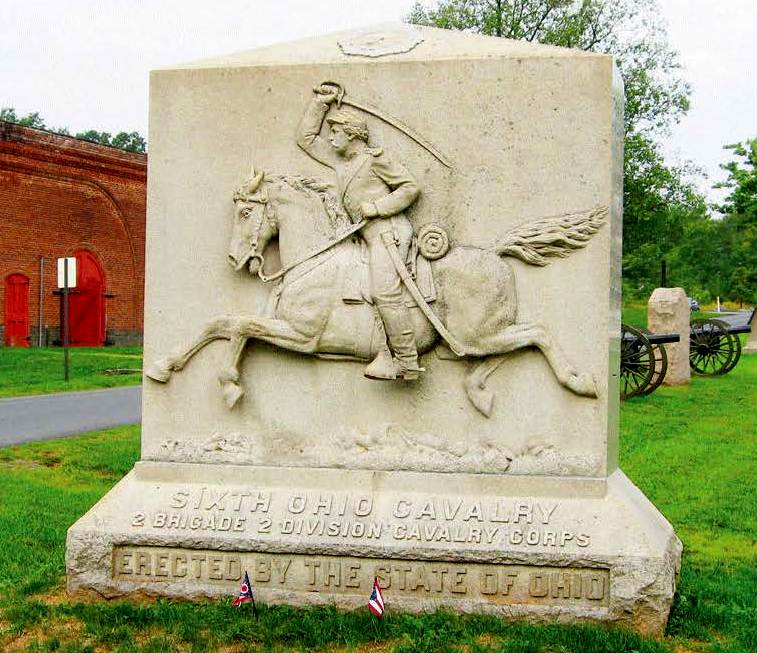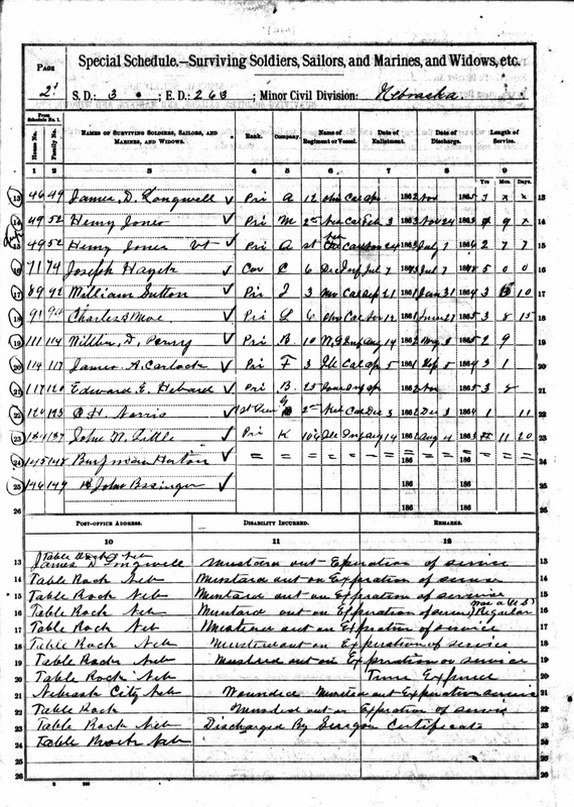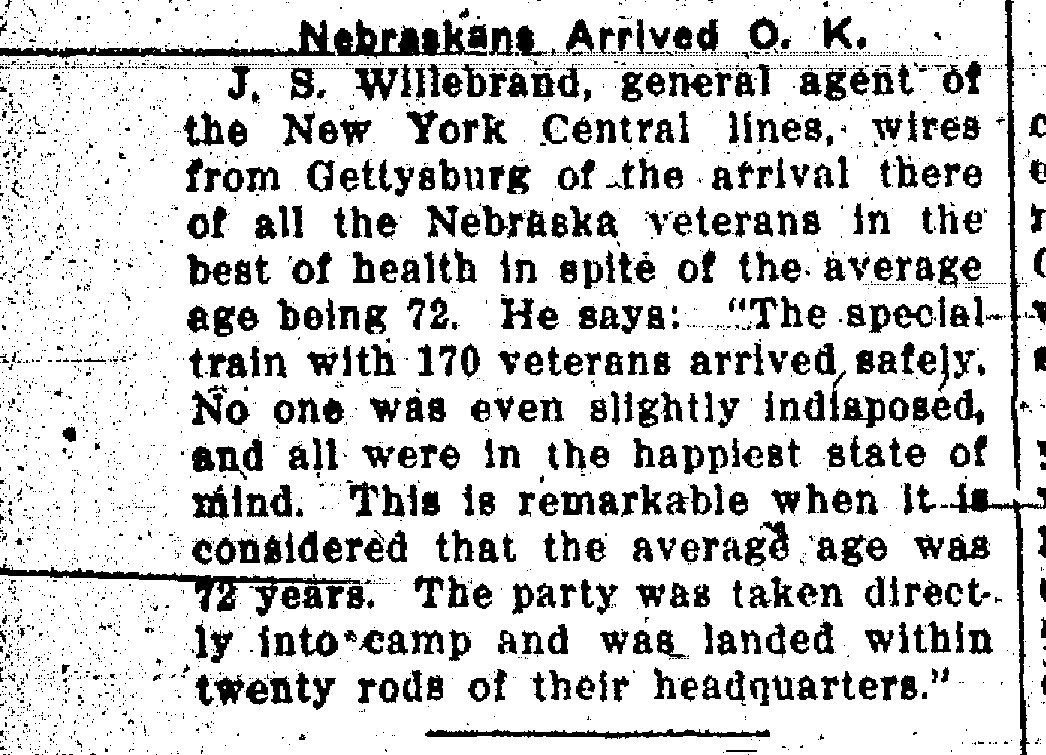stories of civil war veterans
of table rock
The information provided here relates primarily to their military service
All veterans who lived in table rock may be included. this is Unlike the Roll of Honor page, which consists of veterans buried in the cemetery with the exception of several who lived most of their lives in table rock but spent a brief time in declining years elsewhere with children.
ADAM ALLINSON
hiram billings
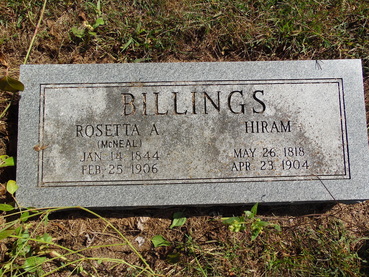
Table Rock resident at time of enlistment.
Company B, 67th Ohio Infantry
Hiram Billings is a Civil War veteran. He came to Table Rock in the 1850s, living in a dug out in the earliest years, as did many of the settlers. After his wife died in 1861, he went back to Ohio to enlist, leaving three young children. His daughter was adopted by the Dimons. What happened to his two sons by his first wife, Nancy, is unknown. He did come back to Table Rock and did remarry. His second wife, Rosetta, was a younger sister of William McNeal, the only Table Rock man who died in the war. They had two children together, a son and a daughter.
He was already 43 years old when he enlisted in Company B of the 67th Ohio Infantry on December 2, 1861. The unit mustered out on December 12, 1865, months after the end of the war. His unit pursued Lee and they were at Appomattox for Lee's surrender.
The following additional information is provided by a regimental history taken from volume 2 of "The Union Army" by Federal Publishing Company, 1908:
Company B, 67th Ohio Infantry
Hiram Billings is a Civil War veteran. He came to Table Rock in the 1850s, living in a dug out in the earliest years, as did many of the settlers. After his wife died in 1861, he went back to Ohio to enlist, leaving three young children. His daughter was adopted by the Dimons. What happened to his two sons by his first wife, Nancy, is unknown. He did come back to Table Rock and did remarry. His second wife, Rosetta, was a younger sister of William McNeal, the only Table Rock man who died in the war. They had two children together, a son and a daughter.
He was already 43 years old when he enlisted in Company B of the 67th Ohio Infantry on December 2, 1861. The unit mustered out on December 12, 1865, months after the end of the war. His unit pursued Lee and they were at Appomattox for Lee's surrender.
The following additional information is provided by a regimental history taken from volume 2 of "The Union Army" by Federal Publishing Company, 1908:
This regiment was to serve three years, but remained in service until after the close of the war. |
gottfried burow
peter gold
henry merwin
charles moe
|
Birth: Jul. 22, 1839 in Ohio
Died Dec. 23, 1904 in Table Rock Private, Company L, 6th Ohio Cavalry. Served August 12, 1861 to June 27, 1865. Michelle Claire Best Willie has provided some information derived from Ancestry.com. Charles' parents were Abraham Perry Moe and Lorinda Dunforth. In 1867, he married Anna H. Shepherd, born about 1845 in Pennsylvania (based on information in the 1885 Nebraska State Census). On the tombstone of their baby daughter Linnie, which is next to theirs, she is listed as the daughter of "Cha. & Annie Moe." |
Charles Moe: He was there. See Line 18.
|
OHIO SIXTH INDEPENDENT CAVALRY COMPANY, A story from the Stringfellow Family History
When Confederate artillery fired on Fort Sumter April 12, 1861, hundreds of horsemen from the Western Reserve counties of Northeast Ohio took up the call. |
Responding to President Lincoln’s request, seventeen hundred fifty-eight riders volunteered for duty with the Sixth Ohio Cavalry Regiment. The Sixth Ohio was mustered into service between October 2 and December 12, 1861 at Camp Hutchison, in Warren, Ohio. The 6th was on duty at Warren until January 1862, and then garrisoned at Camp Chase and Camp Dennison, where they were finally given their horses, until May 1862 when they were ordered to join the Army of the Potomac.
The 6th Ohio Cavalry Regiment lost 5 officers and 52 enlisted men killed and mortally wounded and 4 officers and 177 enlisted men to disease during the Civil War.
The unit clashed with Confederate forces for the first time at Woodstock, Va. June 2, 1862. During the next 34 months, the Sixth would engage the enemy more than 50 times.
The Ohio regiment’s affiliation with the Army of the Potomac led to gallant service at the Second Battle of Manassas, Fredericksburg, Kelley’s Ford (the first pure cavalry fight east of the Mississippi involving a battalion or more on each side), Gettysburg, Yellow Tavern, Cold Harbor, Malvern Hill, Five Forks and Sailor’s Creek.
The 6th was heavily involved in the Gettysburg Campaign, fighting at the Battle of Brandy Station and in several smaller engagements during the Union operations in the Loudoun Valley of Virginia, including the battles of Aldie, Middleburg, and Upperville.
It traveled into Pennsylvania with the division as part of the brigade of Col. Pennock Huey, but before the Battle of Gettysburg withdrew to Westminster, Maryland, to guard the army’s supply trains.
The regiment was active during the retreat of the Confederate Army of Northern Virginia in July.
The Sixth Ohio fought during the final days of the war at Appomattox Courthouse, and was present when General Robert E. Lee surrendered on April 9, 1865. The Regiment was mustered out of service at Petersburg, Va., on August 7, 1865. This Regiment sustained heavy loss in officers and men during its eventful career.
The troopers served under several Division and Brigade Commanders, including Colonel Alfred N. Duffie, Brigadier General William Woods Averell, Brigadier General David McMurtrie Gregg and Major General George Crook. During the 1864 raid in Albemarle County, Va., the unit served under Brigadier General George Armstrong Custer.
The 6th Ohio Cavalry Regiment lost 5 officers and 52 enlisted men killed and mortally wounded and 4 officers and 177 enlisted men to disease during the Civil War.
The unit clashed with Confederate forces for the first time at Woodstock, Va. June 2, 1862. During the next 34 months, the Sixth would engage the enemy more than 50 times.
The Ohio regiment’s affiliation with the Army of the Potomac led to gallant service at the Second Battle of Manassas, Fredericksburg, Kelley’s Ford (the first pure cavalry fight east of the Mississippi involving a battalion or more on each side), Gettysburg, Yellow Tavern, Cold Harbor, Malvern Hill, Five Forks and Sailor’s Creek.
The 6th was heavily involved in the Gettysburg Campaign, fighting at the Battle of Brandy Station and in several smaller engagements during the Union operations in the Loudoun Valley of Virginia, including the battles of Aldie, Middleburg, and Upperville.
It traveled into Pennsylvania with the division as part of the brigade of Col. Pennock Huey, but before the Battle of Gettysburg withdrew to Westminster, Maryland, to guard the army’s supply trains.
The regiment was active during the retreat of the Confederate Army of Northern Virginia in July.
The Sixth Ohio fought during the final days of the war at Appomattox Courthouse, and was present when General Robert E. Lee surrendered on April 9, 1865. The Regiment was mustered out of service at Petersburg, Va., on August 7, 1865. This Regiment sustained heavy loss in officers and men during its eventful career.
The troopers served under several Division and Brigade Commanders, including Colonel Alfred N. Duffie, Brigadier General William Woods Averell, Brigadier General David McMurtrie Gregg and Major General George Crook. During the 1864 raid in Albemarle County, Va., the unit served under Brigadier General George Armstrong Custer.
battle of cold harborThe order of battle at Cold Harbor had he Sixth Ohio Cavalry under the "Cavalry Corps," commanded by General Sheridan. The battle began with the Cavalry Corps: "On May 31, Maj. General Sheridan’s cavalry seized the vital crossroads of Old Cold Harbor. The following morning, Sheridan was able to repulse an attempted repossession by Confederate infantry. Confederate reinforcements soon arrived and clashed with the Union Sixth and Eighteenth Corps when they reached Cold Harbor that evening." From CivilWar.org.
After that, the battle went very wrong for the Union troops. The slaughter resulting from lack of reconnaisance and lack of communication was said to be a new and terrible standard. |
john c. smith
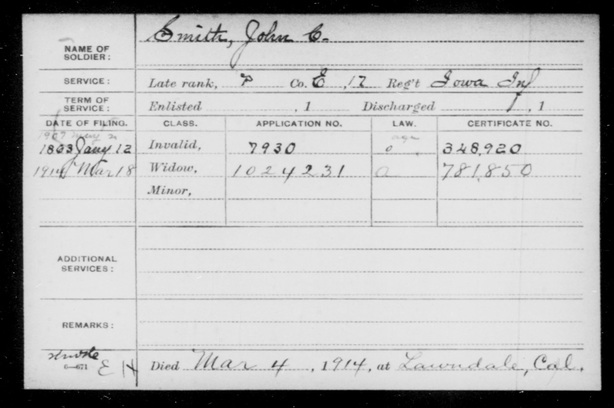
Born in Pensylvania in 1832, died March 4, 1914 in California
Private, Company E
17th Iowa Infantry
Period of service, March 11, 1862 to August 6, 1862, discharged afer Shiloh due to disease
John C. Smith was a member of GAR Post #165 in Table Rock, Nebraska, where he lived for many years. In older times, he was called “Uncle John.”
He was in Table Rock, by 1880, as he appears on the census here, along with his wife, daughters aged 2, 5, and 14 (Florence, ?, and Clara?), and 9 and 11-year-old sons Willie and James A.
He was here until at least July 1913, as the news of the time reflects that he went to the Gettysburg reunion that month. However, he was in California when he died in 1914 and is buried in the GAR section of the Inglewood Cemetery (Los Angeles County).
He had probably moved to California, rather than died during a temporary stay. His wife Sarah did not die until 1929 and is buried next to him. Since she stayed, they presumably had taken up residence, most likely with an adult child. This is all speculation.
He was from Pennsylvania, and had served in the Civil War, enlisting from his then-residence in Wapello County, Iowa. He was a private in Company E of the 17th Iowa Infantry. He served from March 11, 1862 to August 6, 1862 and fought at the famous battle of Shiloh. He was then discharged due to disease.
Oddly, he attended the famous Gettysburg reunion in 1913. That event was limited to veterans of the battle and selections were made by the Grand Army of the Republic. The G.A.R. records about the selection are in the possession of the State Historical Society but offer little more than names, and usually (but not always) the military unit. The veterans going to the Gettysburg reunion had their way paid by the State of Nebraska and once there accommodations and food in an elaborate tent city were furnished by the federal government. It does not appear that his unit was at Gettysburg, yet we know from articles in the newspaper locally and elsewhere, that he was selected and did attend.
Private, Company E
17th Iowa Infantry
Period of service, March 11, 1862 to August 6, 1862, discharged afer Shiloh due to disease
John C. Smith was a member of GAR Post #165 in Table Rock, Nebraska, where he lived for many years. In older times, he was called “Uncle John.”
He was in Table Rock, by 1880, as he appears on the census here, along with his wife, daughters aged 2, 5, and 14 (Florence, ?, and Clara?), and 9 and 11-year-old sons Willie and James A.
He was here until at least July 1913, as the news of the time reflects that he went to the Gettysburg reunion that month. However, he was in California when he died in 1914 and is buried in the GAR section of the Inglewood Cemetery (Los Angeles County).
He had probably moved to California, rather than died during a temporary stay. His wife Sarah did not die until 1929 and is buried next to him. Since she stayed, they presumably had taken up residence, most likely with an adult child. This is all speculation.
He was from Pennsylvania, and had served in the Civil War, enlisting from his then-residence in Wapello County, Iowa. He was a private in Company E of the 17th Iowa Infantry. He served from March 11, 1862 to August 6, 1862 and fought at the famous battle of Shiloh. He was then discharged due to disease.
Oddly, he attended the famous Gettysburg reunion in 1913. That event was limited to veterans of the battle and selections were made by the Grand Army of the Republic. The G.A.R. records about the selection are in the possession of the State Historical Society but offer little more than names, and usually (but not always) the military unit. The veterans going to the Gettysburg reunion had their way paid by the State of Nebraska and once there accommodations and food in an elaborate tent city were furnished by the federal government. It does not appear that his unit was at Gettysburg, yet we know from articles in the newspaper locally and elsewhere, that he was selected and did attend.
|
Sources of information about John C. Smith. This information is contained in the records of Post 165, in a book about the history of Wapello County, Iowa, and on his pension index card, which is available on Fold3. Following his a detailed discussion of these sources.
Post records record his military service as Company E, 17th Iowa Infantry. Using that information, I discovered that his company was mustered in Wapello County, Iowa. There is a book of Wapello county history – The History of Wapello County, Iowa by Waterman, Harrison, Lyman, published in 1914 by S. J. Publishing Company. It includes the roster of company E and also their dates of mustering in and out, http://archive.org/stream/historyofwapello01inwate#page/370/mode/2up, last visited 10/24/15. At page 371 of the book: it is noted that Private John C. Smith enlisted March 11, 1862, and was discharged August 6, 1862 due to disease. Some of this information is also in the U. S. Civil War Draft Registration Records, 1863-1865 for John C. Smith; lived in Agency, Wapello County, Iowa; “Smith, John C., age 31, white, farmer, born Pennsylvania; former military service: “6 ___ 17th Iowa Division” Smith went to the Gettysburg reunion, but the 17th does not appear to have been at Gettysburg. (Wikipedia lists their engagements.) However, during Smith’s period of service, they were at Shiloh, which was in April 1862. He is on 1880 U. S. Census in Table Rock, that record noting that he was born about 1832 in Pennsylvania. Household: John C., age 48 (born Pa parents too); Sarah his wife, age 36, born in Ohio (parents NY and Ohio); children (Clara?), age 14; James. A., age 11; Willie L., 9; ? daughter age 5, Florence, age 2. DEATH: His pension index card is annotated that he died 3/4/1914 at Lawndale, CA. I found his grave there. |
cosmus m. snoke
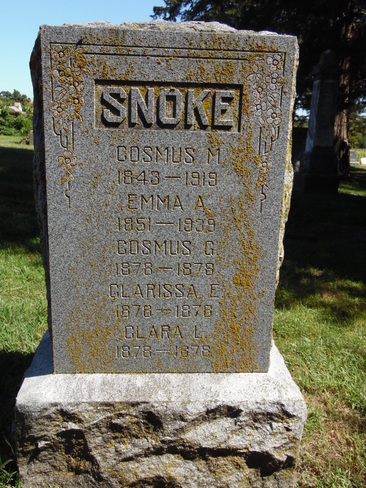
Birth: Dec. 13, 1843
Pennsylvania
Death: Feb. 22, 1919
Nebraska
Private, 1st Battalion, Pennsylvania Infantry (Stewart's Battalion), July 16 to November 14, 1864.
Additional service in Co. A of 48TH “Mil. Infantry,” dates of service not yet found.
The March 7, 1919 Table Rock Argusreprinted an obituary from the Humboldt Standard.
Pennsylvania
Death: Feb. 22, 1919
Nebraska
Private, 1st Battalion, Pennsylvania Infantry (Stewart's Battalion), July 16 to November 14, 1864.
Additional service in Co. A of 48TH “Mil. Infantry,” dates of service not yet found.
The March 7, 1919 Table Rock Argusreprinted an obituary from the Humboldt Standard.
COSMUS MELCHOR SNOKE |
